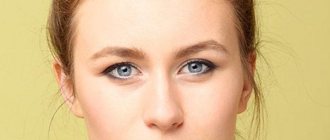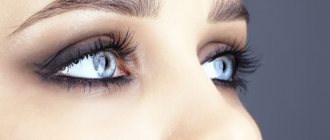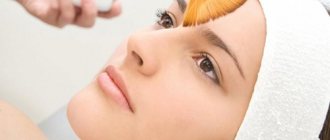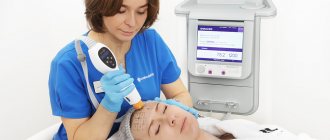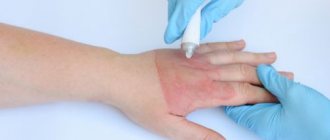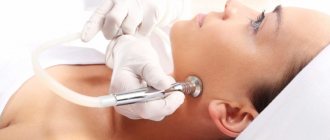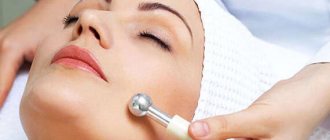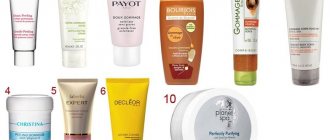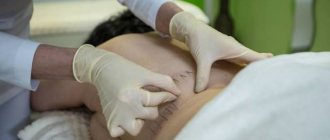What are tapes and what are they used for?
Tape is a cotton tape that has elastic properties and has a hypoallergenic adhesive base. Tapes are attached to the skin of the face; their main task is to provide a lifting effect; the degree of tension is different for each zone. After attaching the tapes, muscle activity of the face decreases, this helps to minimize hypertonicity, lymph circulation becomes free, wrinkles are reduced, swelling decreases, and the general condition of the face improves significantly.
Facial taping is a technique that can be used to reduce the activity of muscle tissue in the facial area. Reduction of expression wrinkles is the most noticeable result, which is visible almost immediately after using the “patch lifting”.
The main advantage of taping is the simplicity of the procedure; you can do it at home yourself. Refresh the face, give it a toned and rested look, reduce wrinkles caused by facial activity, visually lift the eyebrow line, give a more detailed outline to the cheekbones, tighten the oval of the face, make it defined - all this can be done with a kinesiological stretching tape.
Using tapes is quite simple
Kinesio taping was developed back in 1973. The idea of the method implied non-standard fastening of the skin using tapes; it was expected that lymph flow and blood circulation would be concentrated in the area that needed to be healed.
Kinesio taping is similar to the process of applying tape to athletes. The technique helps to avoid injuries and sprains during active sports. The use of tapes in cosmetology became known to mankind relatively recently, but is already quickly gaining popularity.
Methods for correcting facial contours
Modern cosmetology and plastic surgery offers many options for correcting age-related changes, including jowls:
- Administration of drugs based on botulinum toxin.
- Ultrasonic lifting.
- Contour plastic with fillers.
- Various types of plastic surgery.
- Thread lifting.
- Lipolitics.
Not all methods are equally effective and applicable to every patient. Surgical correction has good results, but is used to a limited extent due to postoperative risks and long recovery times. Fillers add volume, but are not suitable for patients with a sufficient amount of their own fatty tissue, since the result of the procedure will be an unnatural puffiness of the face. Botulinum therapy affects muscle tissue, helps smooth out wrinkles, but has no effect on the cause of sagging.
Available and effective methods in this case are thread lifting and the use of lipolytics. They affect the main component of age-related changes - subcutaneous fat deposits. The methods combine safety and good cosmetic results.
When should you start using facial tapes?
For girls who do not experience any special problems with their facial skin, do not suffer from deep wrinkles or swelling, the use of tapes can be recommended from the age of 25. It is during this time period that many people experience the first shallow wrinkles associated with the activity of facial expressions. Taping does a great job of smoothing out such imperfections. Older ladies should not expect amazing results immediately after the procedure; for a visible effect, several “patch lift” procedures should be performed.
Tapes are a great complement to home facial care, as well as facial fitness, known to many. Regular use of the patches is the key to achieving the desired results; the procedure cannot be used “occasionally.”
The duration of applying the tapes can vary from 1 to 8 hours; beauty patches are often left on all night. The effectiveness of taping increases if you maintain skin hydration at the proper level, do self-massage of the face or seek this service from professionals, drink the required amount of clean water, excess fluid in the body can adversely affect and worsen the work of tapes, however, 1.5 liters of clean water per day - required condition.
Removing tapes requires correct and careful actions, otherwise you can get skin damage. To properly remove the patch, you need to pry it from the edge and start rolling it, slowly, without sudden movements, rolling from the central zone to the peripheral one. In cases where reliable fastening of the tape makes it difficult to remove, you can lubricate the edge with oil or moisten it with water.
Abruptly tearing off tapes is strictly prohibited!
Lipolitics for face lifting
Lipolitics are a group of drugs that destroy adipose tissue at the injection site. A reasonable question arises: with age, atrophy of adipose tissue in the upper part of the face already occurs, why is it necessary to additionally use these drugs?
The fact is that, unlike fillers, lipolytics help to acquire a youthful facial contour not with the help of additional volumes, but on the contrary, by reducing problem areas. They are injected only into areas with excess subcutaneous fat. The choice of injection site is made after examining the patient. The procedure involves administering the product with thin needles. As a rule, injections are given in the chin, lower jaw and cheeks. At the same time, adipose tissue breaks down into natural components, which are then utilized by the body.
What results can you get from facial taping?
The intense rhythm of life and constant fatigue affect not only a person’s well-being, they are literally reflected on his face. Of course, you can have wonderful heredity, but sooner or later every woman begins to notice age-related changes in the reflection of the mirror. They undoubtedly upset the owner; she wants to stop time, restore the freshness and elasticity of the skin and find that “magic” remedy that will help visually shed several years, or maybe even a dozen.
Hollywood women have always strived to slow down natural aging, to look younger for as long as possible, and have spent huge amounts of money on cosmetic care. Marlene Dietrich and Joan Crawford were very resourceful ladies, they decided to use glue and silk ribbons for a facelift. As a result, the oval of the face acquired elegance and definition, the skin was perfectly smooth, and meanwhile the “secret of youth” itself was hidden under wigs. Surprisingly, in modern progressive times of plastic correction and medical manipulations, this version of “stage” lifting is also relevant.
Facial tapes
Progress does not stand still and instead of silk tapes with glue, tapes have been developed - adhesive hypoallergenic cotton patches. Body heat is enough to activate the glue and firmly fix the tape on the skin. It is noteworthy that the tape has similar characteristics to human skin, which explains the stimulation of metabolic and recovery processes.
Using the method of applying tapes will help in solving the following aesthetic and cosmetic problems:
- reduction of wrinkles in the mouth area;
- double chin correction;
- reduction of the wrinkled network at the outer corners of the eyes (“crow’s feet”);
- smoothing out wrinkles in the forehead and between the eyebrows caused by the active work of facial expressions;
- reducing the visibility of the folds of the nasolabial triangle;
- facelift;
- reduction of swelling of the lower eyelids;
- opening the gaze due to the lifting of the upper eyelid;
- reduction of age-related appearance in the neck and décolleté area.
Taping quickly improves a person’s condition
In Europe they have already managed to evaluate the results that are achieved with the help of taping. The technique is developing rapidly and gaining a large number of adherents. The effect that is obtained after the “patch lifting” is truly impressive. If you are afraid to go under the surgeon’s knife, but want to look good, then taping is your option. The method is suitable for express rejuvenation if you have an important event at which you want to look young and fresh. Adding tapes to your daily beauty routine will help improve the effectiveness of any care.
How does thread lifting work?
This method of face lifting is based on the introduction of threads made of organic materials into the skin with thin needles. After a certain time, the threads break down into carbon dioxide, water or organic acids, which are then utilized by the body. One of the main effects of threads is stimulation of the synthesis of collagen fibers and enhancement of the reparative properties of the skin. Moreover, water molecules formed after resorption are retained in the dermis, increase skin turgor and prevent it from sagging. Thread lifting allows you to achieve the following effects:
- Move the subcutaneous fat and fix it in the right place.
- Form an additional frame that prevents sagging of soft tissues.
- Stimulate collagen formation.
- Eliminate sagging skin and increase its elasticity.
- Improve the general condition of the skin.
Not all threads have a lifting effect. Some perform only a frame function. The result is influenced by many factors: material, composition, installation depth, initial condition of the skin.
The threads are made from several biomaterials: polydioxanone, polylactic acid and caprolactone. Polydioxanone is absorbed the fastest, and caprolactone remains in the tissues longer than others. To achieve a lifting effect, the threads are introduced not into the epidermis, but into the deeper layers of soft tissue. Passing through the subcutaneous fat, the thread slightly pulls it along with it to the place of its fixation. The threads are usually fixed near the ligaments of the face. When correcting jowls, the thread is most often held by the zygomatic ligament.
The final result is also influenced by the surface of the thread: smooth, spiked or notched. The even texture of the thread does not allow the skin to be tightened and fixed, so after the procedure the threads “slide” from the installation site, and the lifting effect is quickly lost. Barbed threads are best suited for tightening. They are well fixed in tissues for a long time and lift them.
With thread lifting, several correction options are possible. The choice of method depends on the severity of age-related changes and prolapse of soft tissues.
The first option is suitable for patients aged 30–40 years with initial age-related skin changes. It is used to slightly correct the shape of the face and eliminate the initial signs of aging. For this, a small number of threads (2–4) are usually used to tighten problem areas. This option is not suitable for patients with pronounced subcutaneous fat due to the inability of the threads to hold the tissue.
The second method of thread lifting is used in patients 40–50 years old with significant signs of aging, but without significant fat deposits. Typical complaints of patients are the appearance of jowls, pronounced nasolabial folds and general sagging skin. To correct age-related changes, the doctor uses a large number of threads (from 3 on each side).
The third option is applicable for patients over 50–55 years of age or in case of a large amount of subcutaneous fat. The goal of the procedure is to firmly fix the soft tissues and prevent their further prolapse. The doctor may use up to 10 threads or more. The effect of this correction option is the longest lasting.
Recommendations for using tapes
Taping, like any other cosmetic procedure, requires preparation. There is nothing complicated: you need to prepare the skin, warm up the muscle tissue and increase blood flow.
A facial massage will do an excellent job of this task; its duration should be about 5-10 minutes. You can use special massage devices, for example, a facial roller.
Before gluing the tape, for better adhesion, the skin is degreased with any product that contains alcohol. You need to carefully glue the base of the tape or the so-called “anchor”; this part is attached to the skin without tension; if you perform this step with an error, then there will be no point in the further procedure. To avoid damaging the adhesive base, you need to hold the tape by the backing. Carrying out taping at home requires following several rules:
- The face should be cleaned and makeup removed using makeup removers;
- To remove tapes from the skin, first moisten them with water or oil, do not tear them off;
- the main rule of fastening is the direction from bottom to top;
- reliability of fastening increases preliminary degreasing of the skin;
Some parts of the body require rigid fastening of the tape - after the tape is glued, it should be rubbed a little, so the adhesive base is activated faster;
- if you have recently started gluing applications, then the wearing time should not exceed 2 hours (you can start with 30 minutes), the duration of the tapes should increase gradually, the maximum period is 8 hours;
- gluing of tapes should be carried out according to specially developed schemes and taking into account the desired result.
How to choose beauty patches?
Problematic skin prone to rosacea, frequent rashes or allergic reactions requires careful treatment, so you should choose gentle tapes and monitor the skin's reaction to them. Remember: tapes are not applied to the entire face like a mask, the desired result will not be achieved, and the schemes for attaching them were not invented in vain.
Before fixing the tape, its fabric should not be stretched; excessive tension of the skin is also contraindicated. In order for the adhesive base to better adhere to the skin, you need to rub the tape a little after fixing it on the problem area. It is better to avoid the hairline; overexertion can cause headaches and damage the hair follicles.
After taping, after 15 minutes you should monitor the result to exclude the appearance of asymmetry or creases on the skin. If you plan to sleep with an application on your face, then you should forget about sleeping on your stomach, otherwise age-related changes will not take long to come.
You need to choose only good tapes
The initial result may be pleasantly shocking. The key to success will be the correct application of tapes, regularity of the procedure and time, because muscle memory cannot be changed in several sessions.
It is better to purchase tapes at pharmacies. It is better to avoid purchasing from unverified sellers in order to reduce the risk of purchasing a low-quality product that will not help achieve the desired effect.
What affects the change in the lower third of the face
A person’s emotionality also leaves its mark. His natural expression wrinkles are transformed into static folds that lie in the lip area, pulling them down, giving his face a sad expression. In addition, the shape of the face in general, and the lower third in particular, is extremely influenced by the presence of bruxism (periodically occurring episodes of involuntary contraction of the chewing muscles, accompanied by clenching of the jaw). Prolonged tension of the masticatory muscles visually makes the lower third of the face heavier and leads to a change in the shape of the face. The face of such patients becomes square, in some cases leading to asymmetry. Visually makes the oval heavier and the tension of the platysma muscles becomes heavier. Soft tissues are pulled down, which leads to a change in the shape of the face and asymmetry. In some patients, the chin area becomes heavier due to an increase in the volume of adipose tissue. This can occur due to poor nutrition and lifestyle, and due to genetic predisposition - if the parents also have a pronounced fat trap in the submental area.
The most common patient complaints about changes in the lower third of the face:
- the appearance of wrinkles;
- increased expression of physiological folds;
- drooping corners of the mouth and decreased lip volume;
- changing the shape of the chin;
- soft tissue ptosis;
- deformation of the oval of the face.
The most common wishes of patients for correction:
- provide lifting of soft tissues of the face;
- reduce the depth of folds and wrinkles;
- improve the oval of the face;
- change (reduce or increase) the width of the face;
- raise the corners of the mouth;
- adjust the shape of the lips and chin;
- harmonize appearance (for example, create a more feminine, sensual image).
Contraindications for using tapes
It is better to avoid using tapes in the following cases:
- your skin is damaged, there are microtraumas, cuts, purulent rashes, postoperative traces;
- have skin diseases (eczema, psoriasis);
- there is a high risk of allergy to the adhesive base of the tape (use is possible only after conducting a test on an inconspicuous area of skin, which gave a negative answer);
- any aggravated diseases;
- diseases of the circulatory system;
- diseases of the lymphatic system;
- oncological diseases;
- diseases of the ENT organs;
- inflammatory processes of the facial nerves;
- increased body temperature;
- headache.
If there are contraindications, it is better not to use tape
If this list of contraindications does not apply to you, then you can safely use tapes in the fight for youth and freshness of your face!
Taping rules
Kinesiology is the science of movement. This is a branch of alternative non-drug diagnostic medicine, which is based on the study of the functioning of muscles and the nervous system. Therefore, for home use of tapes on the face or body, it is very better to first undergo training, become familiar with the basics of anatomy and physiology to understand the location of muscles, lymph nodes, and blood vessels.
When working with tapes, there are several principles to consider. Let's take a closer look.
Allergy test
Although quality tapes do not contain any harmful components, individual reactions to acrylic adhesives, paints or bleaches do occur. Therefore, it is necessary to do a test if:
- you are using tapes for the first time;
- bought products from a new manufacturer;
- doubt the authenticity of the product.
Principles of allergy testing:
- A test piece 3 cm long and 2 cm wide is glued to the protruding part of the cheekbone. The skin in this area is quite sensitive, but not as delicate as on the neck or around the eyes.
- The sample is left overnight and removed in the morning.
- If there is redness or paleness under the tape, this is a normal reaction that will go away after washing. An allergy is indicated by a small rash, itching, and peeling. In this case, you need to try a tape from another manufacturer, preferably undyed, flesh-colored or white.
Skin preparation
Cleansing is the first important step in taping. Kinesio tapes should not be applied over makeup or oily creams. This can cause irritation, acne, and poor, uneven adhesion of the adhesive.
Taping can be used as a single procedure after applying skincare cosmetics or used to prolong the effect of massage or face fitness. To do this you need:
- Remove makeup thoroughly.
- Apply a moisturizer or massage product.
- Do the exercises.
- Cleanse your face with tonic and cleansing gel.
- Dry the skin completely.
If you want to use tapes in combination with serums and creams, then you need to wait for them to absorb for about 30–40 minutes, and remove the remaining residue with a napkin. The skin should be completely dry and clean.
If the sebaceous glands are overactive, you can use alcohol-containing tonics after washing. It is better not to use rubbing alcohol, as it can enhance the properties of acrylic glue.
Cutting applications
For tapes you need sharp scissors. Suitable:
- tailor's;
- long stationery;
- medical, for dressings.
There are also special tape scissors with Teflon coating, a serrated cutting edge and blunt, safe tips. They prevent the strips from stretching when cutting, sticking to the blades, or forming snags.
On all but the smallest applications, it is necessary to round the corners so that the strips stick better, do not cling to hair, or curl at the edges.
Gluing tapes
There are three types of taping. All of them have a specific purpose, depending on the pattern and degree of tension:
- for lifting;
- drainage;
- myofascial.
Lifting and increasing tone is achieved by working the facial muscles, so the tape is applied with a slight tension - about 5% to create the necessary resistance.
The myofascial effect can be achieved in the opposite way: the skin is stretched, not the tape, and the desired muscle is fixed in a relaxed state. In this way, expression and age wrinkles are quickly removed.
The lymphatic drainage properties of the tape are created by gluing it without tension. Due to its own elasticity, the tape lifts the upper layers of the skin, increasing the intercellular space and freeing the lymphatic ducts and valves, blood vessels. It is important to follow the direction of the therapeutic lines when applying - from the problem area to the nearest lymph nodes. In this case, the tape itself should gather into an “accordion” 15–20 minutes after installation. This phenomenon is called convolution, which means that the tape is working correctly.
Tape activation and overlay control
The adhesive properties of acrylic glue increase when heated, so after gluing the applique, you need to lightly rub it with light stroking movements, along the entire length until you feel warm. If this is not done, the tape will not work as it should and will begin to peel off.
You should always check any application in front of a mirror 15-20 minutes after application. There should be no creases, overhangs of the skin, folds on the tapes or under them.
Removing tapes
High-quality kinesio tapes can usually be removed without problems if a moisturizer is used first. But acrylic glue has one feature: at high temperatures it activates more strongly. If you wet the application with hot water or accidentally blow it with a hairdryer, the tape may stick to your body very strongly.
There are several methods for atraumatic removal:
- rolling;
- separation of the skin from the tape at an acute angle;
- soaking with cosmetic or vegetable oil.
The skin of the face is very delicate and sensitive; tearing off the tapes with force can easily damage and stretch it.
General advantages and disadvantages of aesthetic taping
Strengths of taping:
- Budget cost. Tapes do not cost exorbitant amounts of money; they are publicly available. If you calculate how much trips to a cosmetologist’s office can cost, then taping can be regarded as a home care option that will not make a hole in a woman’s budget.
- You can do it yourself. Mastering the technique of applying tapes is not difficult. The help of a specialist may be needed only during the first procedures, but many do without it. If you want to carry out taping correctly, then it is not a good idea to consult a specialist.
- Taping is a non-invasive method. If you are not ready to radically change your appearance with the help of plastic surgery or “beauty injections,” then you will definitely like anti-aging patches!
- Does not cause discomfort. If you attach the tapes strictly according to the scheme and taking into account all the recommendations, then there will be no unpleasant sensations. Rather, a relaxing effect is observed; overstrain is relieved from the facial muscles.
- A small list of contraindications. It is much easier to prepare for taping of the facial area than for a circular facelift; you just need to study the diagram and technique of gluing, you do not need to undergo special training or a bunch of tests.
The only drawback of rejuvenation using strips is the short duration of the result. Taping is a non-drastic method to restore youth; it is more suitable for correction, but if you use it together with comprehensive care, you can consolidate the effect for a longer time. If you apply tapes incorrectly, they can aggravate the situation, emphasize wrinkles, and have the opposite effect to the expected one.
How many procedures do you need to do to get visible results?
Applications for shaping facial contours are carried out in a course of 21 days. Then you can repeat 1-2 times a week for prevention. If the skin reacts well, no peeling or irritation appears, the course can be extended if necessary.
It is important to understand that until the root cause of jowls is eliminated, taping will not give the expected effect. You will see some results, but they will be very unstable.
To prevent ptosis from getting worse, constantly monitor your posture, perform exercises to warm up your neck and a special set of gymnastics to tighten the oval.
On aged skin 50+, taping should be carried out on the upper, middle and lower parts of the face simultaneously, using up to 5 schemes per procedure, but no more. Working on just one zone is useless. Each application has its own estimated time, so you need to draw up a plan and timing in advance.
Photos before and after using facial tapes
Photos before and after facial taping No. 1
Photos before and after facial taping No. 2
Photos before and after facial taping No. 3
Photos before and after facial taping No. 4
Photos before and after facial taping No. 5
Doctors' opinions
Experienced doctors are of the opinion that facial taping can give the desired effect if done correctly:
Another doctor who is actively involved in taping also confirms the effectiveness of the method, but notes that for the desired result it is very important to perform it according to a certain scheme. We have given different options above. Here's what the doctor says:
It is also worth noting the words of cosmetologist Astrid Oveyan, who recommends using tapes at a young age.
Real reviews
People who have already tried the facial taping method speak mostly positively about it. Here is one of the reviews from a 45-year-old woman who, in just 3 months, was able to significantly improve her appearance thanks to this method:
And this girl was very worried about pronounced nasolabial folds. Thanks to tapes, she was able to make them less noticeable:
Another real positive review:
